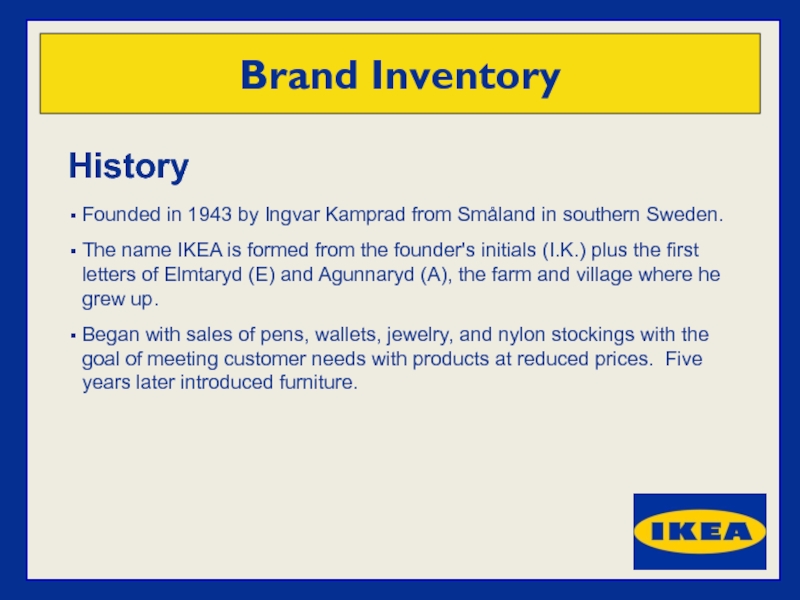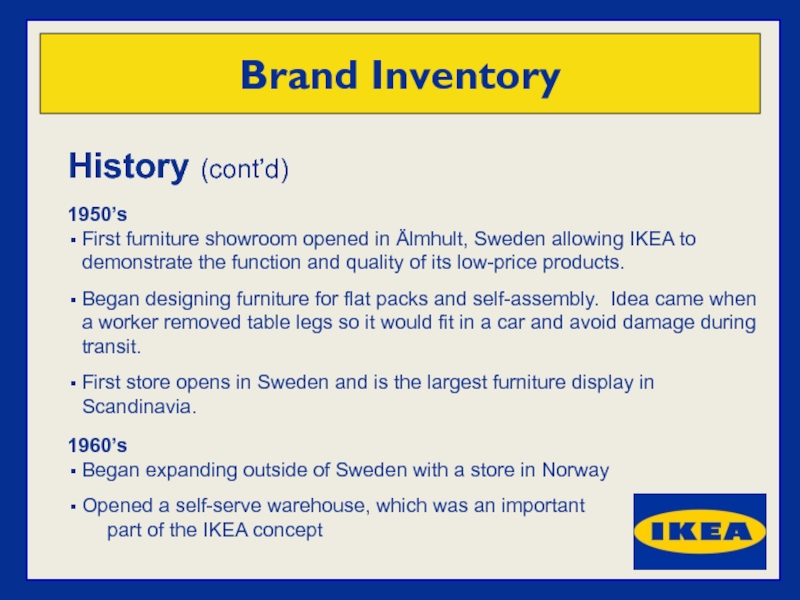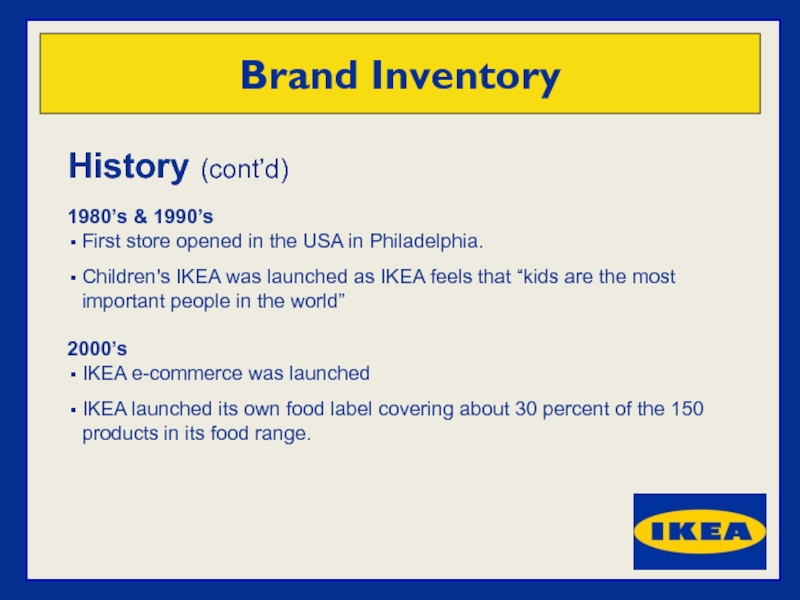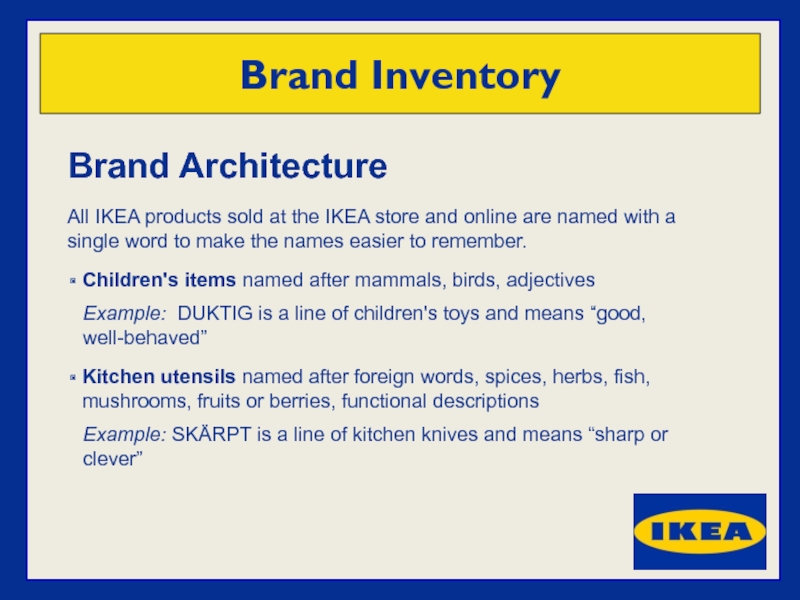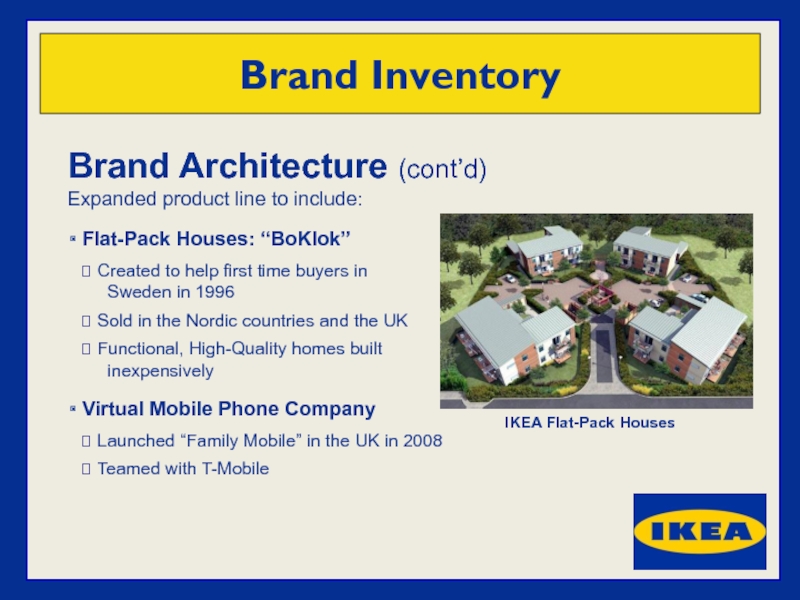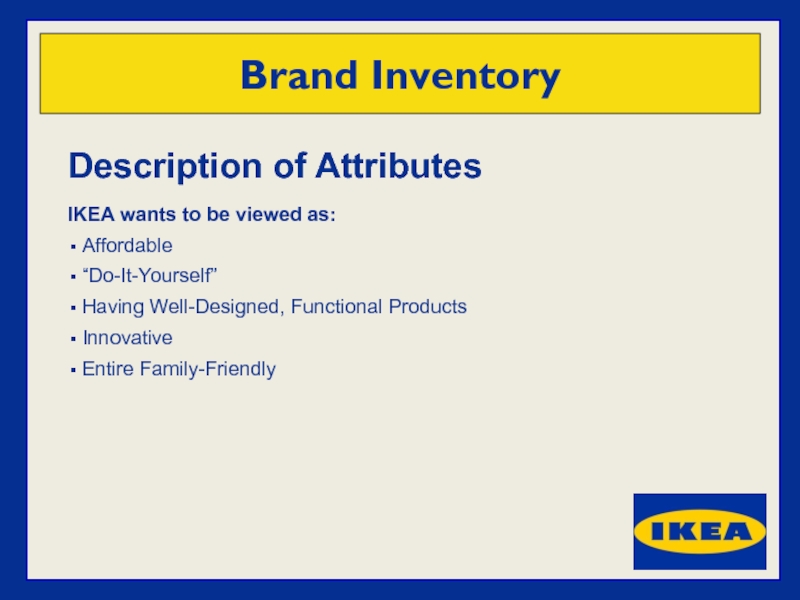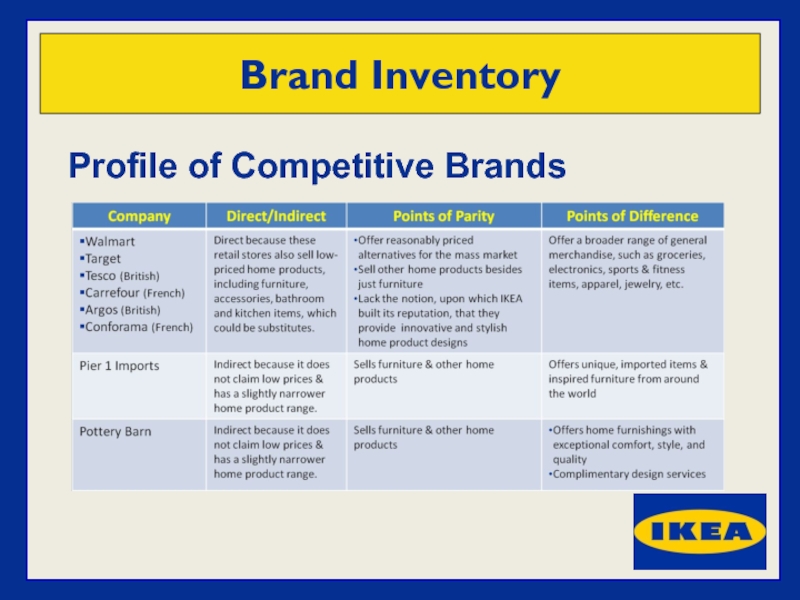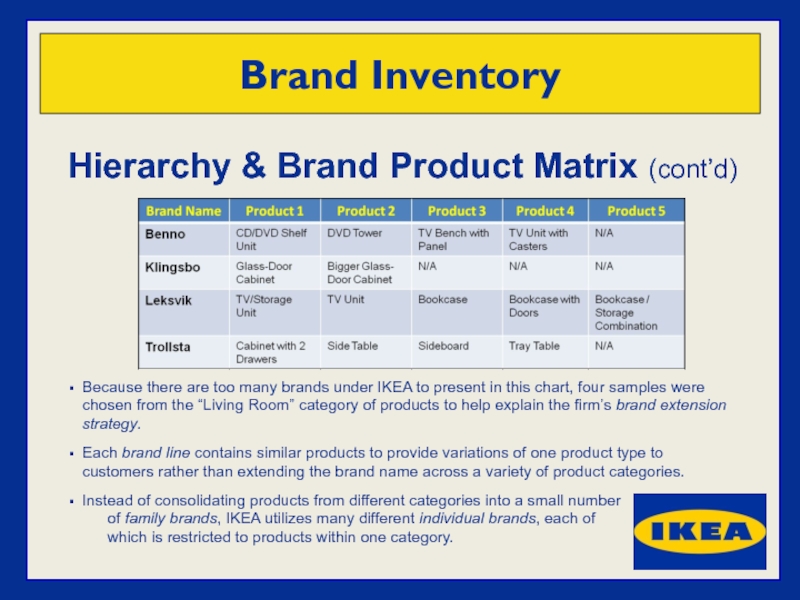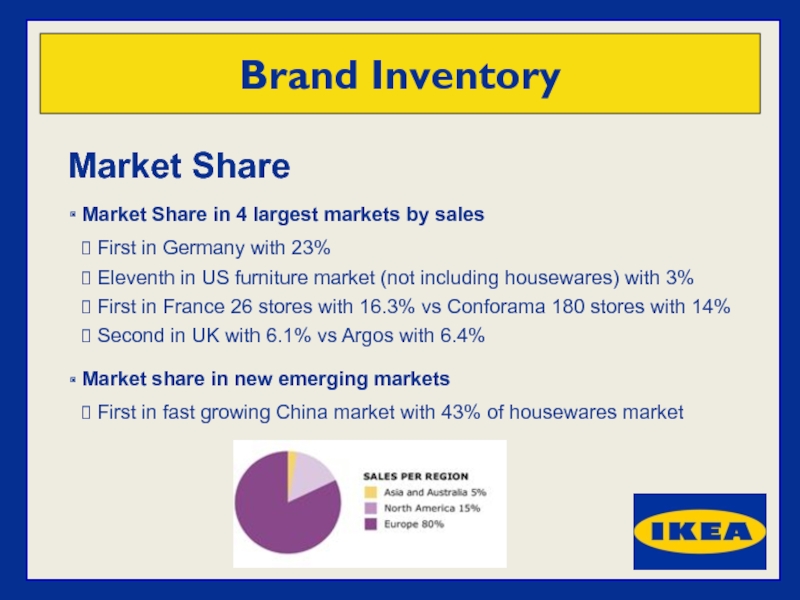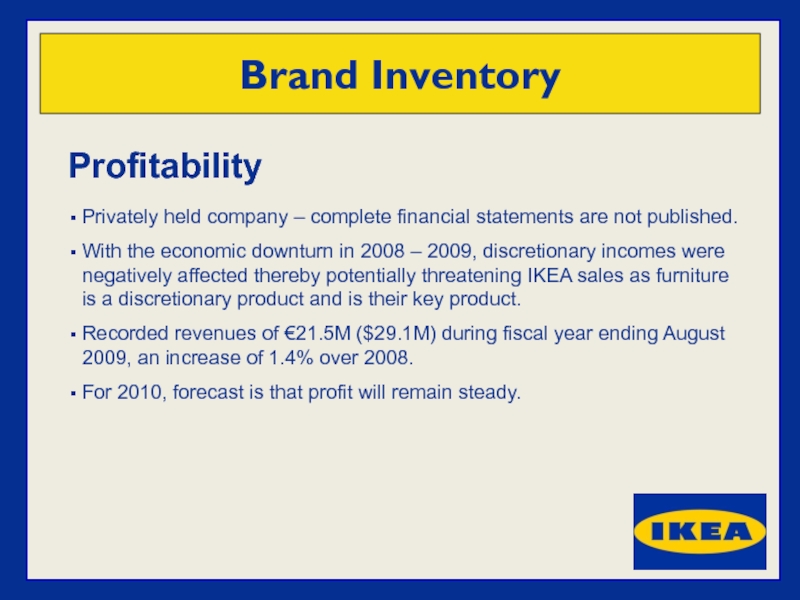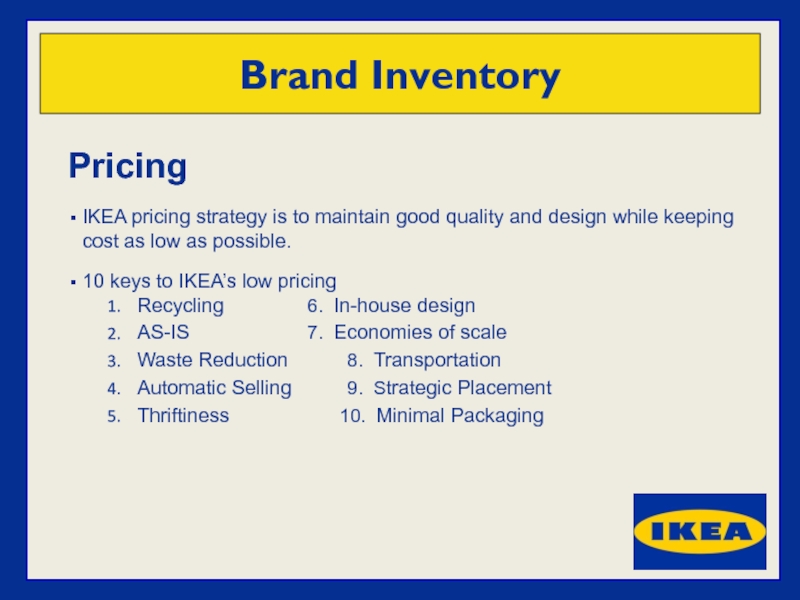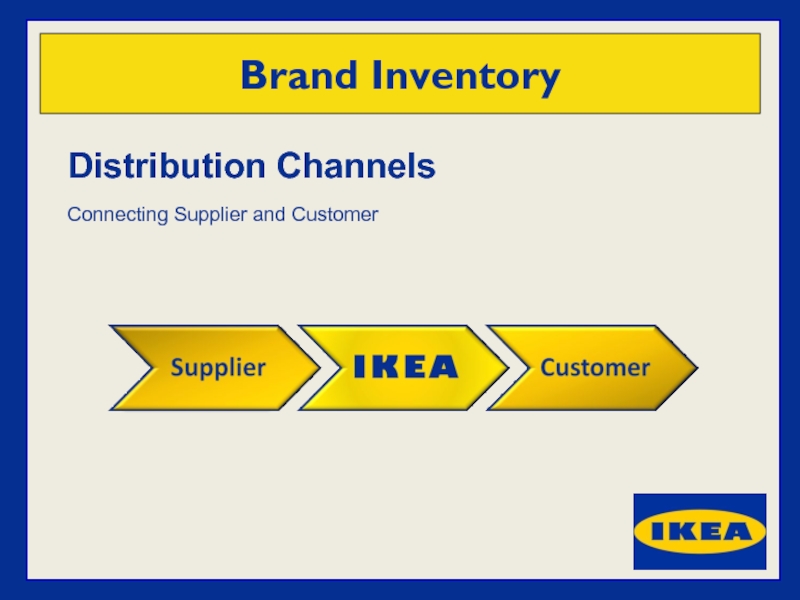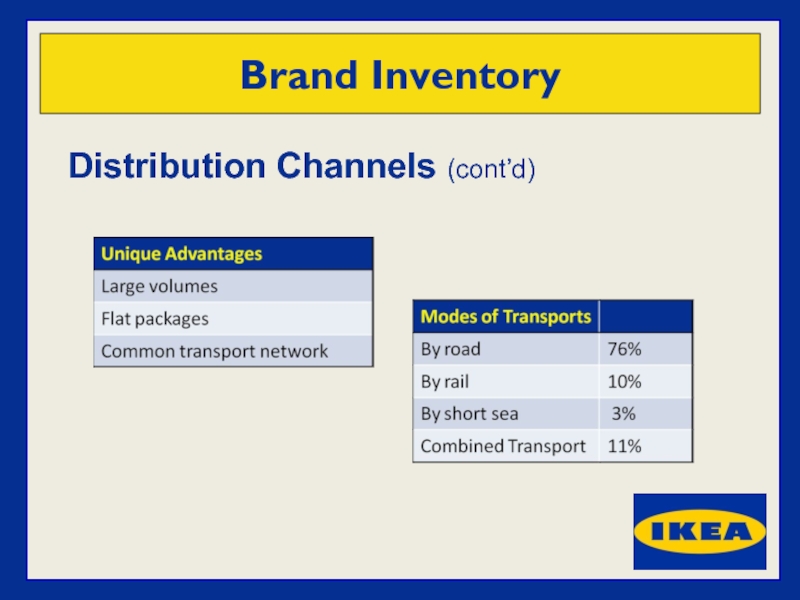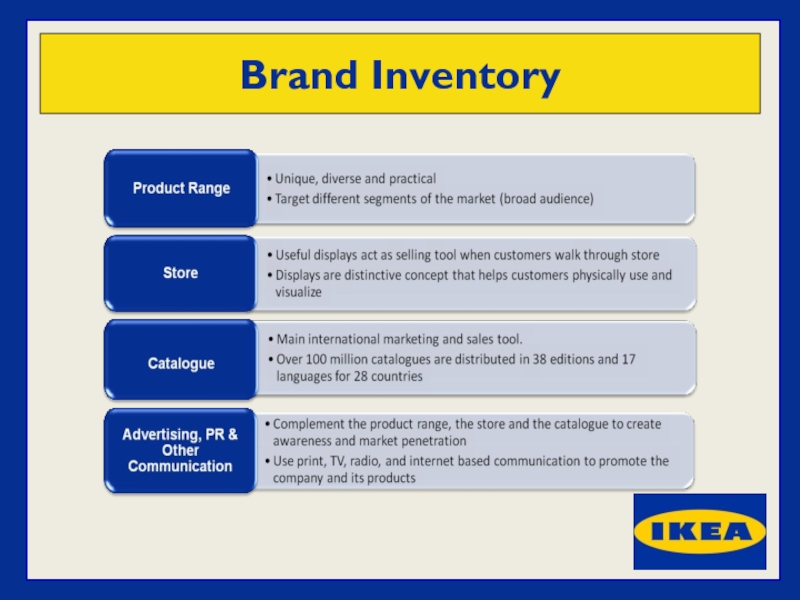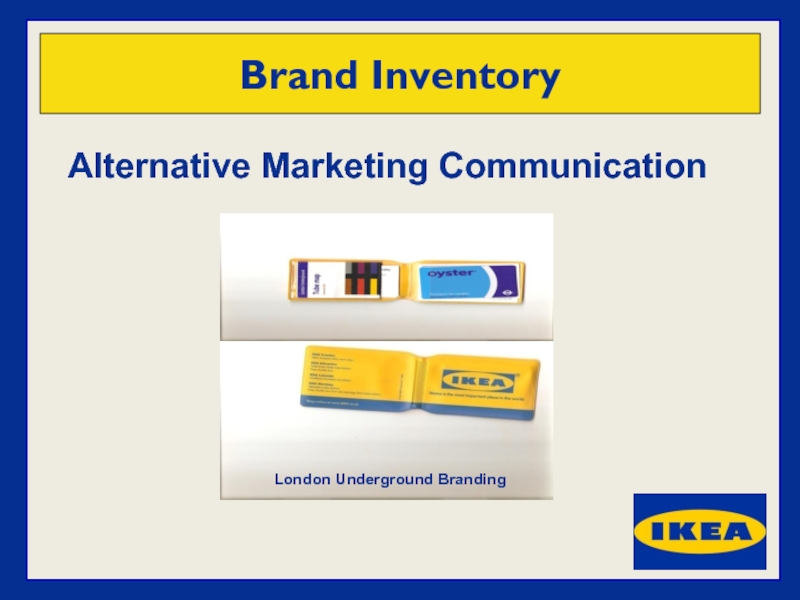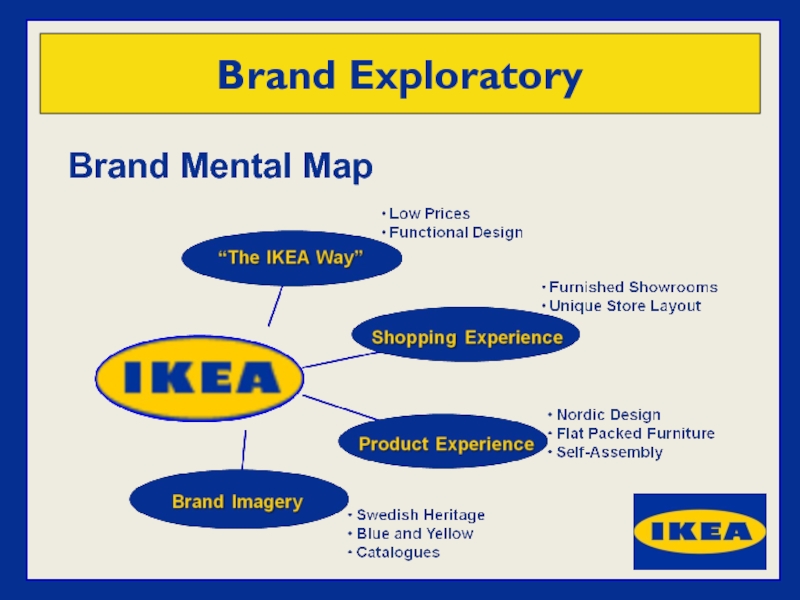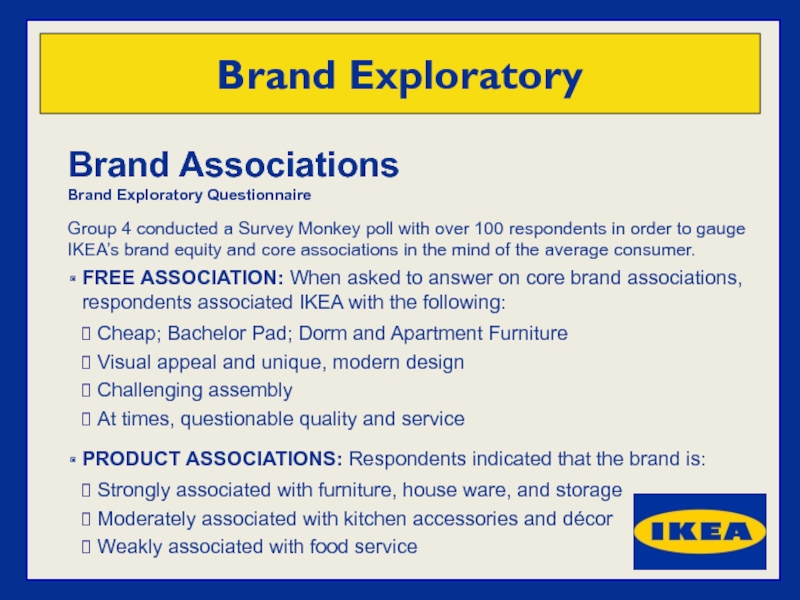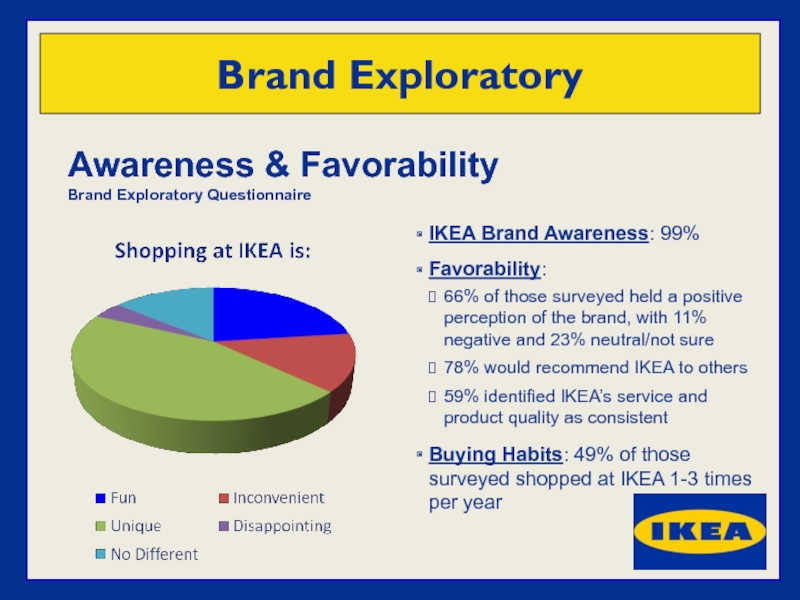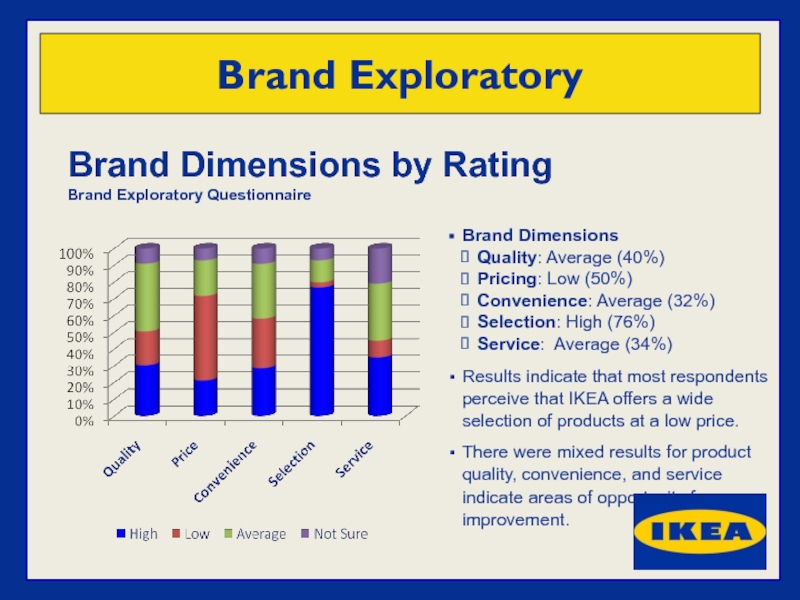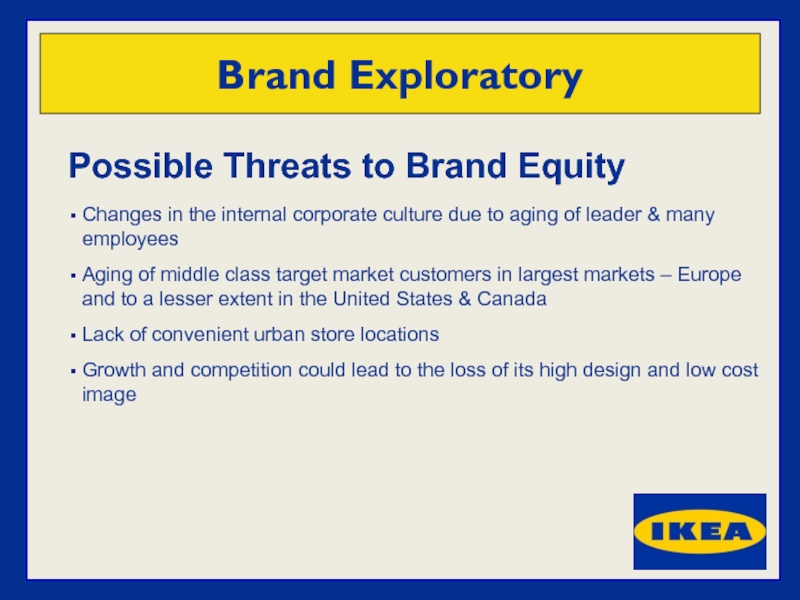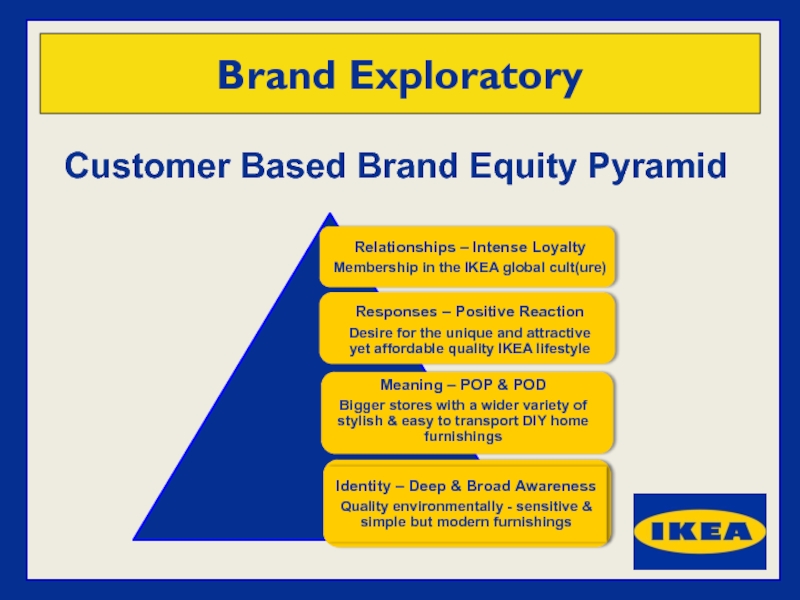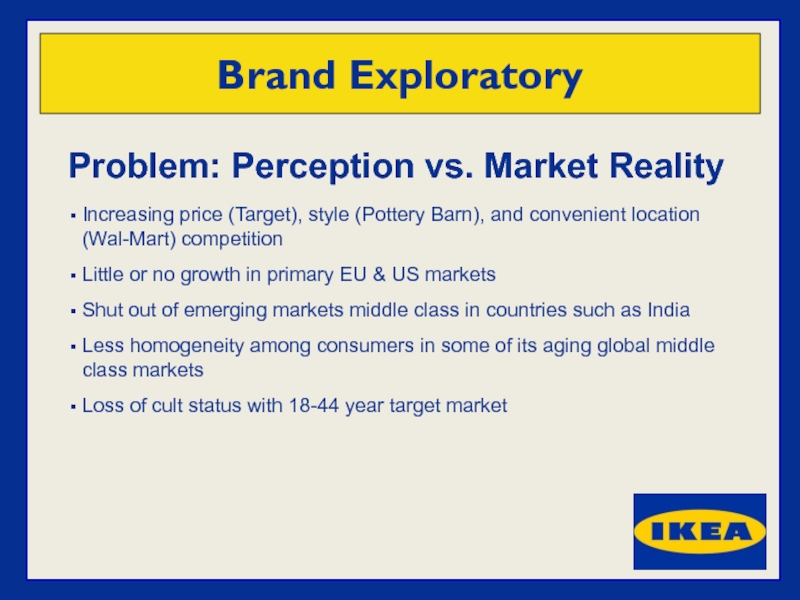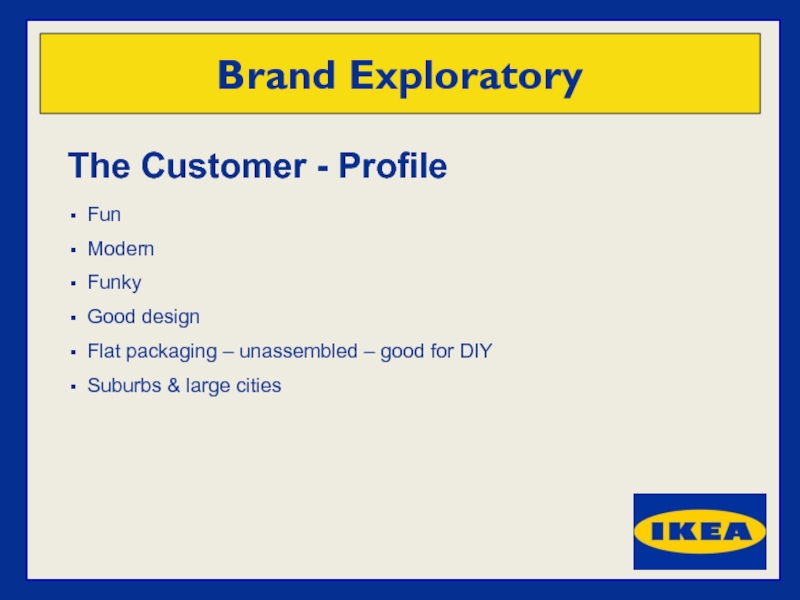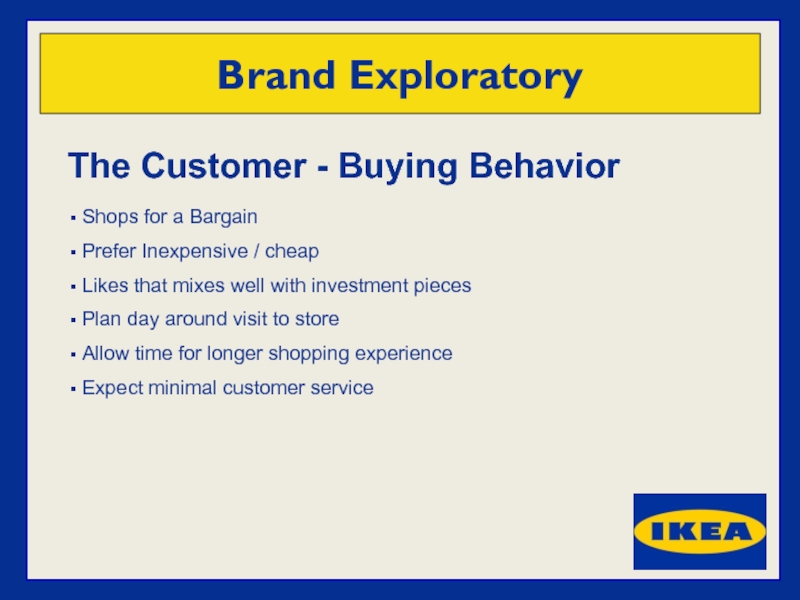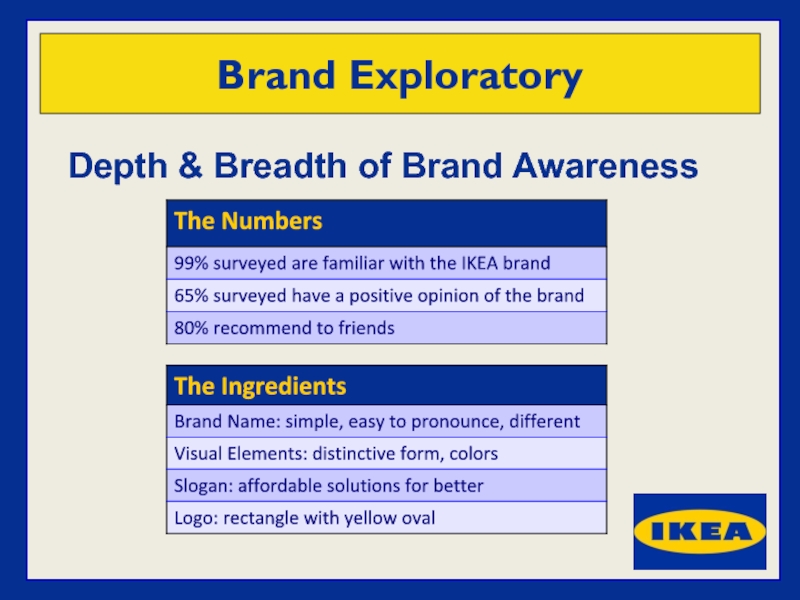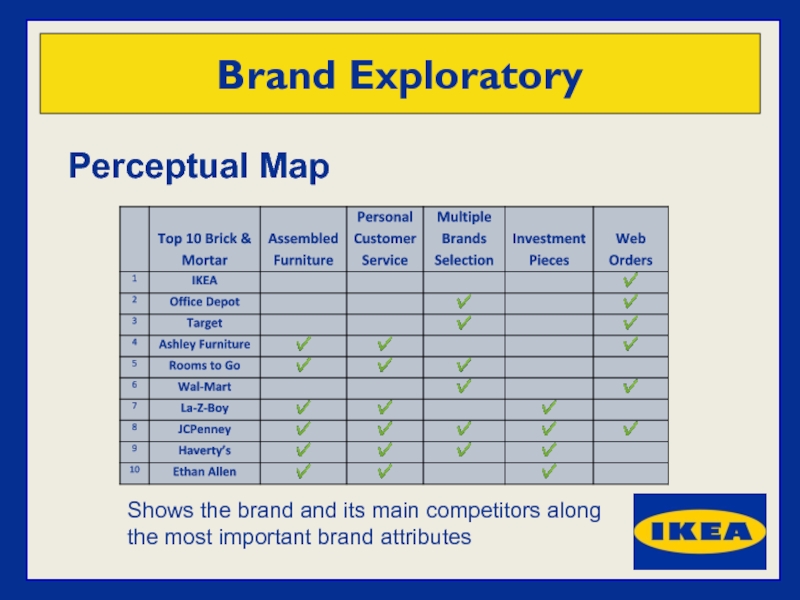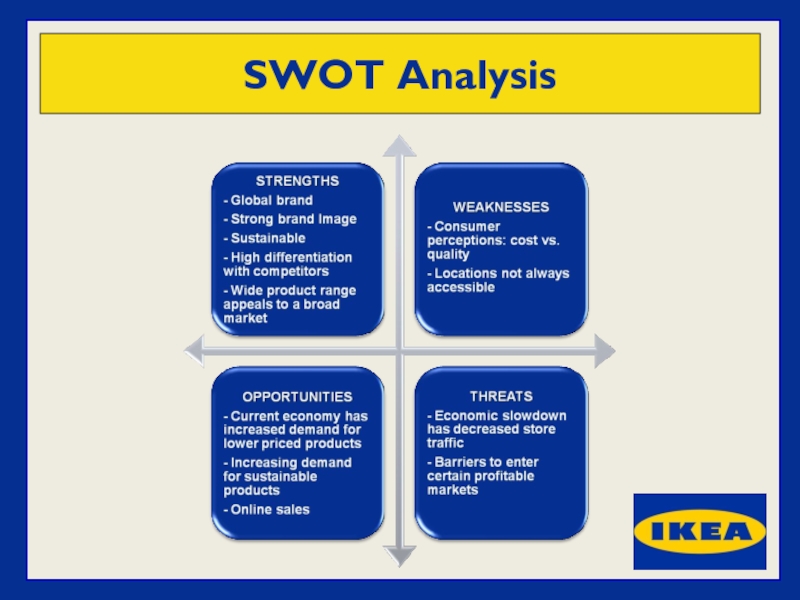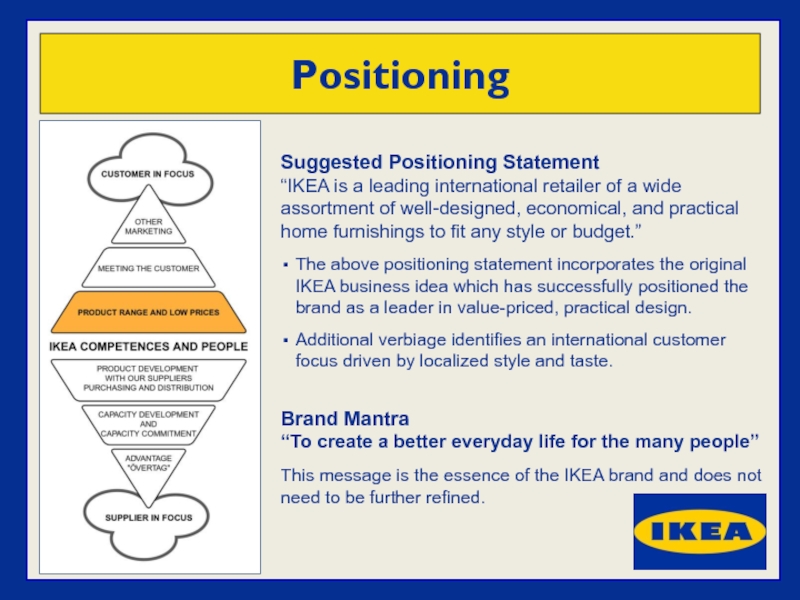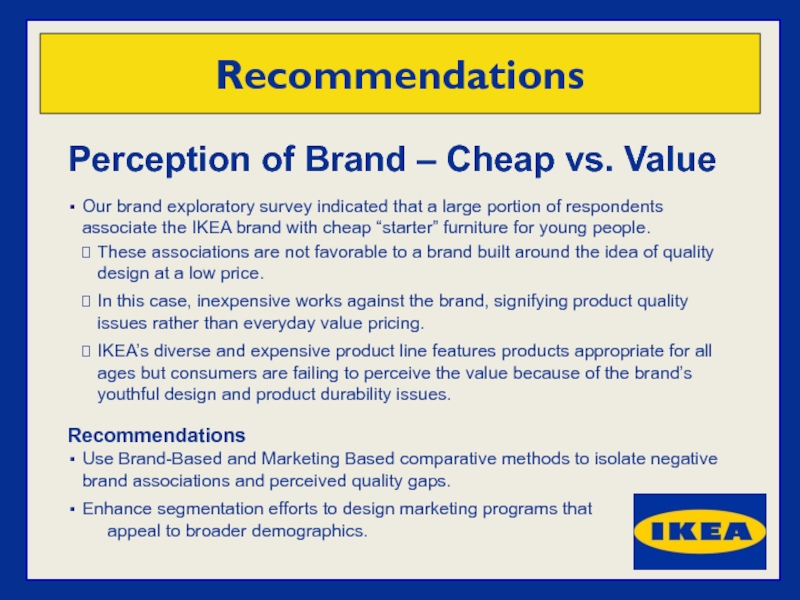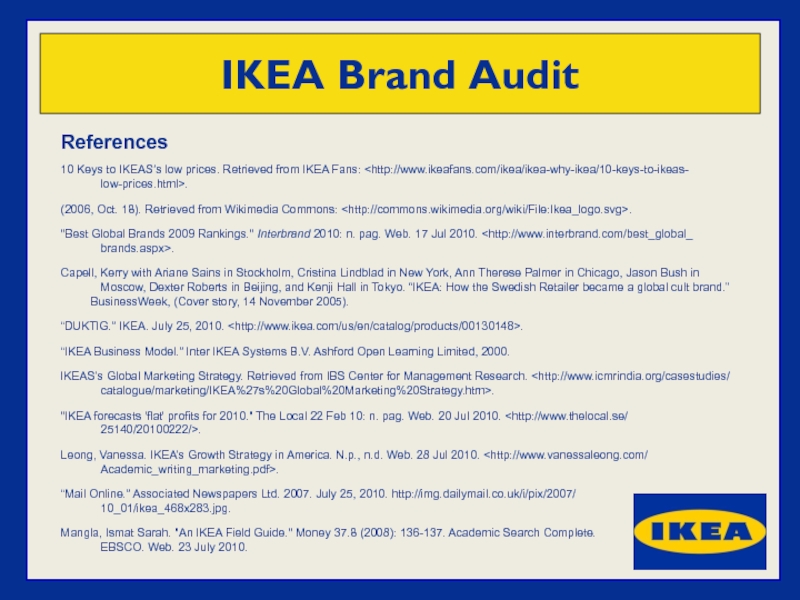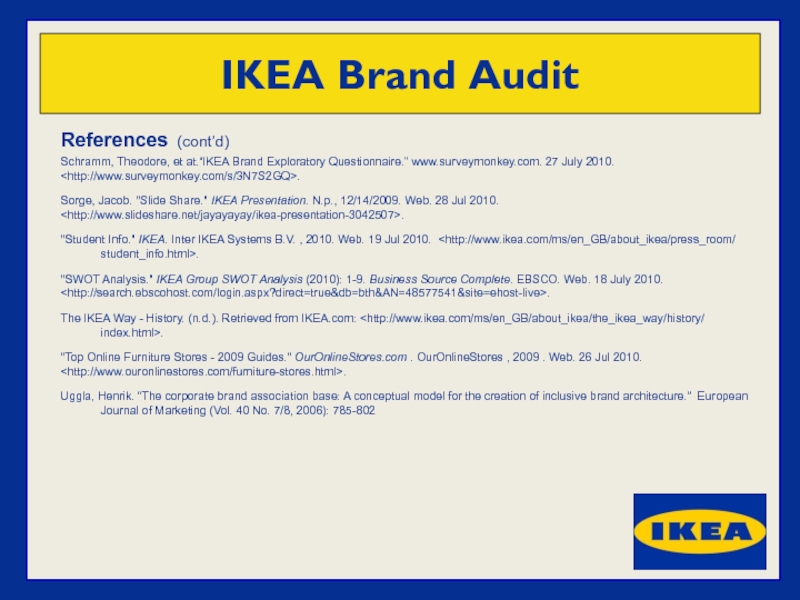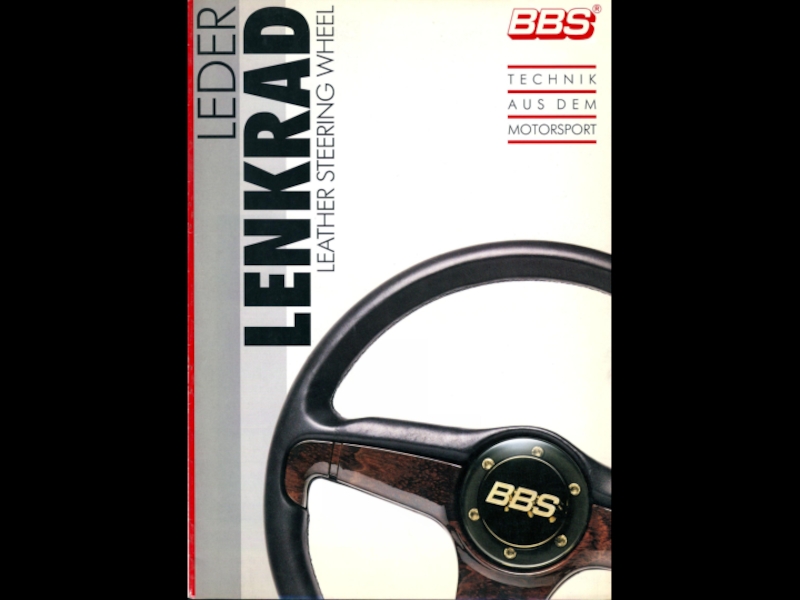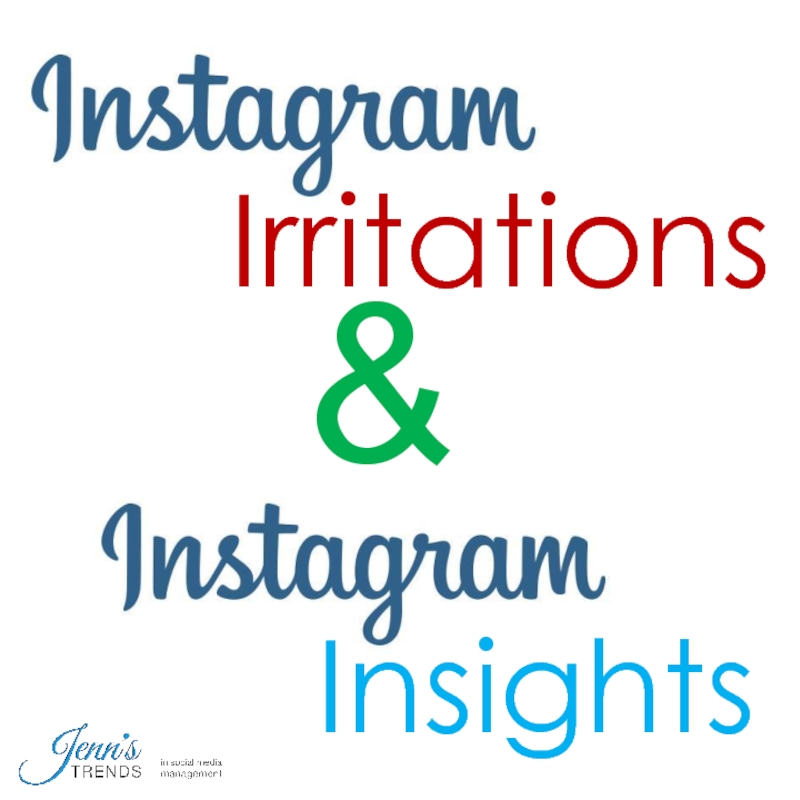- Главная
- Разное
- Дизайн
- Бизнес и предпринимательство
- Аналитика
- Образование
- Развлечения
- Красота и здоровье
- Финансы
- Государство
- Путешествия
- Спорт
- Недвижимость
- Армия
- Графика
- Культурология
- Еда и кулинария
- Лингвистика
- Английский язык
- Астрономия
- Алгебра
- Биология
- География
- Детские презентации
- Информатика
- История
- Литература
- Маркетинг
- Математика
- Медицина
- Менеджмент
- Музыка
- МХК
- Немецкий язык
- ОБЖ
- Обществознание
- Окружающий мир
- Педагогика
- Русский язык
- Технология
- Физика
- Философия
- Химия
- Шаблоны, картинки для презентаций
- Экология
- Экономика
- Юриспруденция
Ikea. Brand inventory презентация
Содержание
- 1. Ikea. Brand inventory
- 2. History Founded in 1943
- 3. History (cont’d) 1950’s First
- 4. History (cont’d) 1980’s &
- 5. Hiring Process 4-steps Brand Inventory
- 6. Brand Elements Single brand
- 7. Brand Inventory Brand Architecture
- 8. Brand Inventory Brand Architecture (cont’d)
- 9. Brand Inventory Description of Attributes
- 10. Profile of Competitive Brands Brand Inventory
- 11. Hierarchy & Brand Product Matrix
- 12. Hierarchy & Brand Product Matrix
- 13. Market Share Market Share
- 14. Profitability Privately held company
- 15. Pricing IKEA pricing
- 16. Distribution Channels Connecting Supplier and Customer Brand Inventory
- 17. Distribution Channels (cont’d) Brand Inventory
- 18. Supporting Marketing The IKEA
- 19. Brand Inventory
- 20. Brand Personality Reflected by the Brand Elements and Existing Marketing Mix Brand Inventory
- 21. Brand Inventory Alternative Marketing Communication
- 22. Brand Mental Map Brand Exploratory
- 23. Brand Associations Brand Exploratory Questionnaire
- 24. Awareness & Favorability Brand Exploratory
- 25. Brand Dimensions by Rating Brand
- 26. Sources of Brand Equity
- 27. Possible Threats to Brand Equity
- 28. Customer Based Brand Equity Pyramid Brand Exploratory
- 29. Problem: Perception vs. Market Reality
- 30. The Customer According to
- 31. The Customer - Profile
- 32. The Customer - Buying Behavior
- 33. The Numbers Depth & Breadth of Brand Awareness Brand Exploratory
- 34. Perceptual Map Brand Exploratory Shows the
- 35. SWOT Analysis
- 36. Positioning Suggested Positioning Statement “IKEA is
- 37. Recommendations Expensive e-commerce Shipping Promote
- 38. Complex Product Names Change Product
- 39. Recommendations Perception of Brand – Cheap
- 40. References 10 Keys to
- 41. IKEA Brand Audit References (cont’d)
Слайд 2
History
Founded in 1943 by Ingvar Kamprad from Småland in southern Sweden.
The
Began with sales of pens, wallets, jewelry, and nylon stockings with the goal of meeting customer needs with products at reduced prices. Five years later introduced furniture.
Brand Inventory
Слайд 3
History (cont’d)
1950’s
First furniture showroom opened in Älmhult, Sweden allowing IKEA to
Began designing furniture for flat packs and self-assembly. Idea came when a worker removed table legs so it would fit in a car and avoid damage during transit.
First store opens in Sweden and is the largest furniture display in Scandinavia.
1960’s
Began expanding outside of Sweden with a store in Norway
Opened a self-serve warehouse, which was an important
part of the IKEA concept
Brand Inventory
Слайд 4
History (cont’d)
1980’s & 1990’s
First store opened in the USA in Philadelphia.
Children's IKEA was launched as IKEA feels that “kids are the most important people in the world”
2000’s
IKEA e-commerce was launched
IKEA launched its own food label covering about 30 percent of the 150 products in its food range.
Brand Inventory
Слайд 6
Brand Elements
Single brand element is the simple and bold typeface logo
Simplicity
Colors are the same yellow and blue national colors of Sweden, the birthplace of the founder
Is a registered trademark which means unauthorized use is subject to legal action
Consists of simple geometric shapes and text, and does not meet the threshold of originality needed for copyright protection
Brand Inventory
Слайд 7
Brand Inventory
Brand Architecture
All IKEA products sold at the IKEA store
Children's items named after mammals, birds, adjectives
Example: DUKTIG is a line of children's toys and means “good, well-behaved”
Kitchen utensils named after foreign words, spices, herbs, fish, mushrooms, fruits or berries, functional descriptions
Example: SKÄRPT is a line of kitchen knives and means “sharp or clever”
Слайд 8
Brand Inventory
Brand Architecture (cont’d)
Expanded product line to include:
Flat-Pack Houses: “BoKlok”
Created
Sweden in 1996
Sold in the Nordic countries and the UK
Functional, High-Quality homes built
inexpensively
Virtual Mobile Phone Company
Launched “Family Mobile” in the UK in 2008
Teamed with T-Mobile
Слайд 9
Brand Inventory
Description of Attributes
IKEA wants to be viewed as:
Affordable
“Do-It-Yourself”
Having Well-Designed,
Innovative
Entire Family-Friendly
Слайд 11
Hierarchy & Brand Product Matrix
IKEA products are organized into categories based
Each series name applies to only one product category, while the IKEA name is applied across all of the different product categories. The IKEA name, therefore, functions as the family brand as well as the company brand, and the two levels collapse to one.
Brand Inventory
Слайд 12
Hierarchy & Brand Product Matrix (cont’d)
Brand Inventory
Because there are too many
Each brand line contains similar products to provide variations of one product type to customers rather than extending the brand name across a variety of product categories.
Instead of consolidating products from different categories into a small number
of family brands, IKEA utilizes many different individual brands, each of
which is restricted to products within one category.
Слайд 13
Market Share
Market Share in 4 largest markets by sales
First in Germany
Eleventh in US furniture market (not including housewares) with 3%
First in France 26 stores with 16.3% vs Conforama 180 stores with 14%
Second in UK with 6.1% vs Argos with 6.4%
Market share in new emerging markets
First in fast growing China market with 43% of housewares market
Brand Inventory
Слайд 14
Profitability
Privately held company – complete financial statements are not published.
With the
Recorded revenues of €21.5M ($29.1M) during fiscal year ending August 2009, an increase of 1.4% over 2008.
For 2010, forecast is that profit will remain steady.
Brand Inventory
Слайд 15
Pricing
IKEA pricing strategy is to maintain good quality and design
10 keys to IKEA’s low pricing
Recycling 6. In-house design
AS-IS 7. Economies of scale
Waste Reduction 8. Transportation
Automatic Selling 9. Strategic Placement
Thriftiness 10. Minimal Packaging
Brand Inventory
Слайд 18
Supporting Marketing
The IKEA brand builds on a relationship with the consumer.
The
IKEA marketing communication utilizes key principles to build the relationship with the customer and give an understanding of how they meet customers needs.
Brand Inventory
Слайд 23
Brand Associations
Brand Exploratory Questionnaire
Group 4 conducted a Survey Monkey poll with
FREE ASSOCIATION: When asked to answer on core brand associations, respondents associated IKEA with the following:
Cheap; Bachelor Pad; Dorm and Apartment Furniture
Visual appeal and unique, modern design
Challenging assembly
At times, questionable quality and service
PRODUCT ASSOCIATIONS: Respondents indicated that the brand is:
Strongly associated with furniture, house ware, and storage
Moderately associated with kitchen accessories and décor
Weakly associated with food service
Brand Exploratory
Слайд 24
Awareness & Favorability
Brand Exploratory Questionnaire
Brand Exploratory
IKEA Brand Awareness: 99%
Favorability:
66% of those
78% would recommend IKEA to others
59% identified IKEA’s service and product quality as consistent
Buying Habits: 49% of those surveyed shopped at IKEA 1-3 times per year
Слайд 25
Brand Dimensions by Rating
Brand Exploratory Questionnaire
Brand Exploratory
Brand Dimensions
Quality: Average (40%)
Pricing: Low
Convenience: Average (32%)
Selection: High (76%)
Service: Average (34%)
Results indicate that most respondents perceive that IKEA offers a wide selection of products at a low price.
There were mixed results for product quality, convenience, and service indicate areas of opportunity for improvement.
Слайд 26
Sources of Brand Equity
Cult like following of customers
Common customer experience globally
Modern
Self assembly = quality goods for lower cost
Shared global middle class buying habits
Middle class market growth opportunities*
Fun but frugal internal corporate culture
Brand Exploratory
Слайд 27
Possible Threats to Brand Equity
Changes in the internal corporate culture due
Aging of middle class target market customers in largest markets – Europe and to a lesser extent in the United States & Canada
Lack of convenient urban store locations
Growth and competition could lead to the loss of its high design and low cost image
Brand Exploratory
Слайд 29
Problem: Perception vs. Market Reality
Increasing price (Target), style (Pottery Barn), and
Little or no growth in primary EU & US markets
Shut out of emerging markets middle class in countries such as India
Less homogeneity among consumers in some of its aging global middle class markets
Loss of cult status with 18-44 year target market
Brand Exploratory
Слайд 30
The Customer
According to our research, about 50% of consumers go to
Dorm furniture: college students
Kid’s rooms: parents/children
Babies-Teens
Teenagers
Starter furniture
Bachelor pads: young men 18-25
Brand Exploratory
Слайд 31
The Customer - Profile
Fun
Modern
Funky
Good design
Flat
Suburbs & large cities
Brand Exploratory
Слайд 32
The Customer - Buying Behavior
Shops for a Bargain
Prefer Inexpensive /
Likes that mixes well with investment pieces
Plan day around visit to store
Allow time for longer shopping experience
Expect minimal customer service
Brand Exploratory
Слайд 34
Perceptual Map
Brand Exploratory
Shows the brand and its main competitors along the
Слайд 36
Positioning
Suggested Positioning Statement
“IKEA is a leading international retailer of a wide
The above positioning statement incorporates the original IKEA business idea which has successfully positioned the brand as a leader in value-priced, practical design.
Additional verbiage identifies an international customer focus driven by localized style and taste.
Brand Mantra
“To create a better everyday life for the many people”
This message is the essence of the IKEA brand and does not need to be further refined.
Слайд 37
Recommendations
Expensive e-commerce Shipping
Promote a Temporary Discount on Shipping Rates
Free shipping
Sign up for loyalty program and get free shipping
Measuring Effectiveness
If the promotion is successful, it will generate additional online sales.
Current online shipping rates:
Слайд 38
Complex Product Names
Change Product Names to Fit the Market
Take from Globalization
Easier to remember
Easier to start buzz about product
Measure Effectiveness of Recommendation using Conjoint Analysis
Do you like ‘DUGTIG’ as the name for this product?
Do you like ‘TEA TIME’ as the name for this product?
Recommendations
Слайд 39
Recommendations
Perception of Brand – Cheap vs. Value
Our brand exploratory survey
These associations are not favorable to a brand built around the idea of quality design at a low price.
In this case, inexpensive works against the brand, signifying product quality issues rather than everyday value pricing.
IKEA’s diverse and expensive product line features products appropriate for all ages but consumers are failing to perceive the value because of the brand’s youthful design and product durability issues.
Recommendations
Use Brand-Based and Marketing Based comparative methods to isolate negative brand associations and perceived quality gaps.
Enhance segmentation efforts to design marketing programs that
appeal to broader demographics.
Слайд 40
References
10 Keys to IKEAS’s low prices. Retrieved from IKEA Fans: .
(2006,
"Best Global Brands 2009 Rankings." Interbrand 2010: n. pag. Web. 17 Jul 2010.
Capell, Kerry with Ariane Sains in Stockholm, Cristina Lindblad in New York, Ann Therese Palmer in Chicago, Jason Bush in
Moscow, Dexter Roberts in Beijing, and Kenji Hall in Tokyo. “IKEA: How the Swedish Retailer became a global cult brand.” BusinessWeek, (Cover story, 14 November 2005).
“DUKTIG.” IKEA. July 25, 2010.
“IKEA Business Model.” Inter IKEA Systems B.V. Ashford Open Learning Limited, 2000.
IKEAS’s Global Marketing Strategy. Retrieved from IBS Center for Management Research.
"IKEA forecasts 'flat' profits for 2010." The Local 22 Feb 10: n. pag. Web. 20 Jul 2010.
Leong, Vanessa. IKEA’s Growth Strategy in America. N.p., n.d. Web. 28 Jul 2010.
“Mail Online.” Associated Newspapers Ltd. 2007. July 25, 2010. http://img.dailymail.co.uk/i/pix/2007/
10_01/ikea_468x283.jpg.
Mangla, Ismat Sarah. "An IKEA Field Guide." Money 37.8 (2008): 136-137. Academic Search Complete.
EBSCO. Web. 23 July 2010.
IKEA Brand Audit
Слайд 41
IKEA Brand Audit
References (cont’d)
Schramm, Theodore, et at.“IKEA Brand Exploratory Questionnaire.” www.surveymonkey.com.
Sorge, Jacob. "Slide Share." IKEA Presentation. N.p., 12/14/2009. Web. 28 Jul 2010.
"Student Info." IKEA. Inter IKEA Systems B.V. , 2010. Web. 19 Jul 2010.
"SWOT Analysis." IKEA Group SWOT Analysis (2010): 1-9. Business Source Complete. EBSCO. Web. 18 July 2010.
The IKEA Way - History. (n.d.). Retrieved from IKEA.com:
"Top Online Furniture Stores - 2009 Guides." OurOnlineStores.com . OurOnlineStores , 2009 . Web. 26 Jul 2010.
Uggla, Henrik. “The corporate brand association base: A conceptual model for the creation of inclusive brand architecture.” European
Journal of Marketing (Vol. 40 No. 7/8, 2006): 785-802

